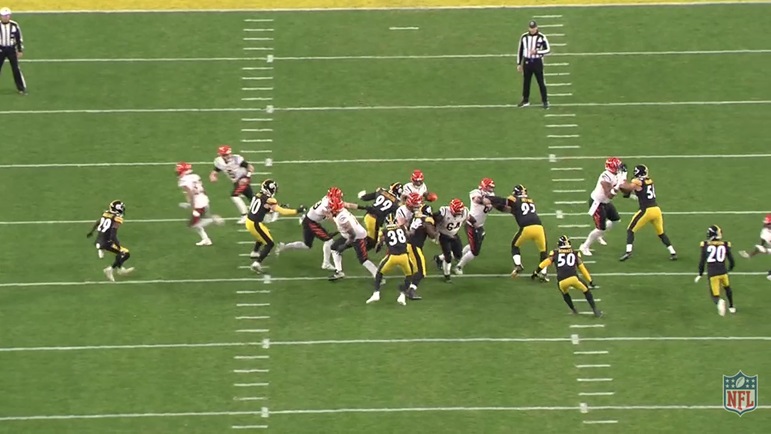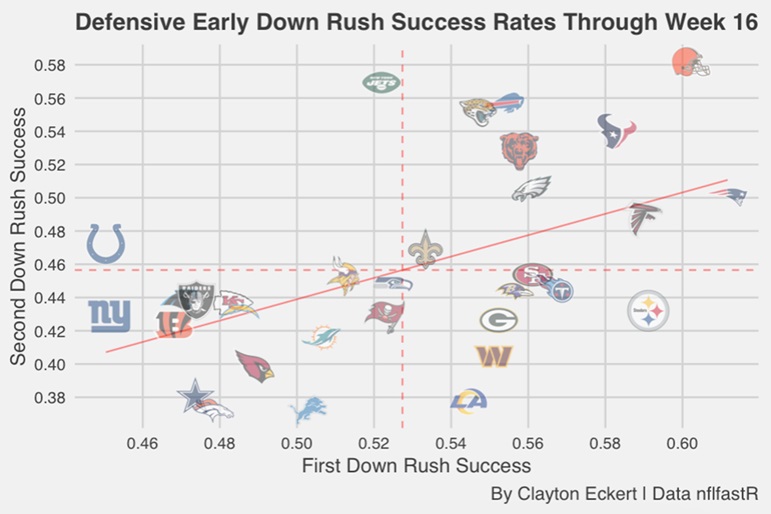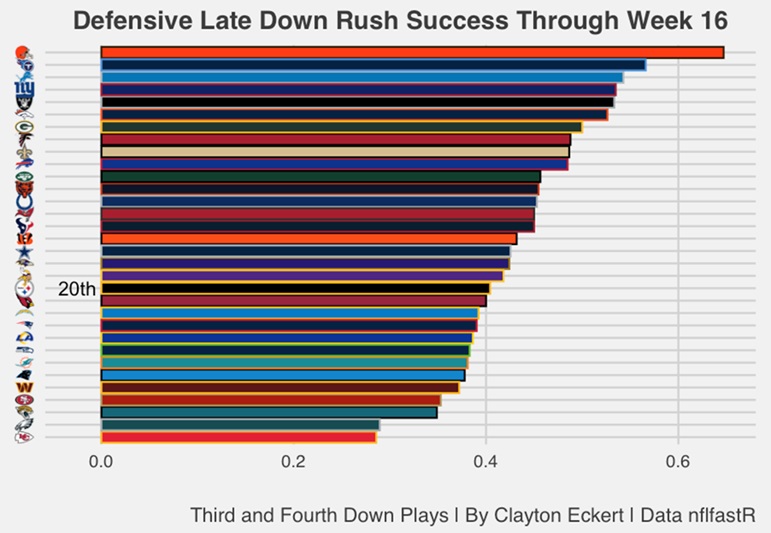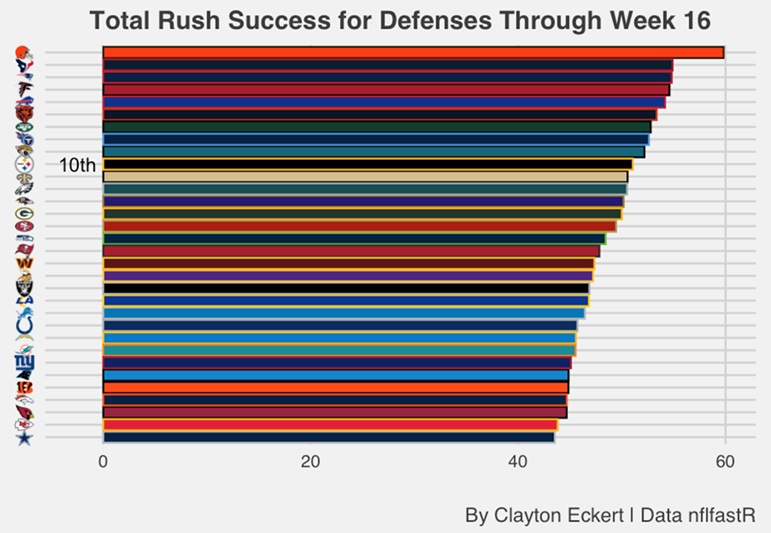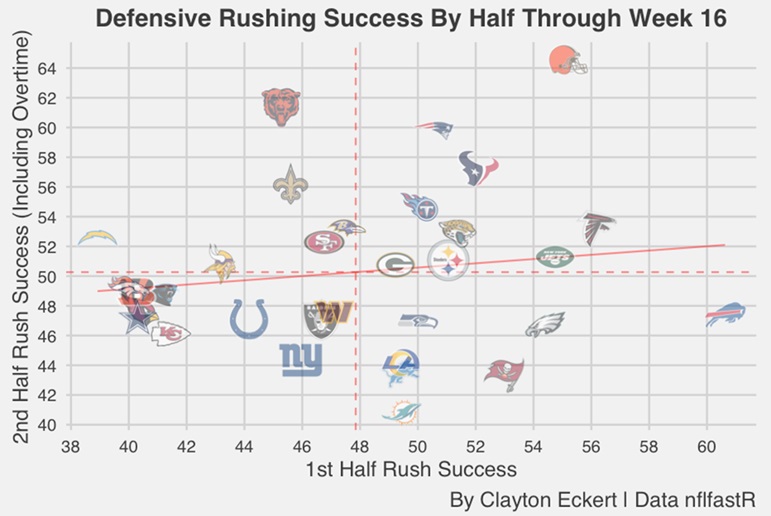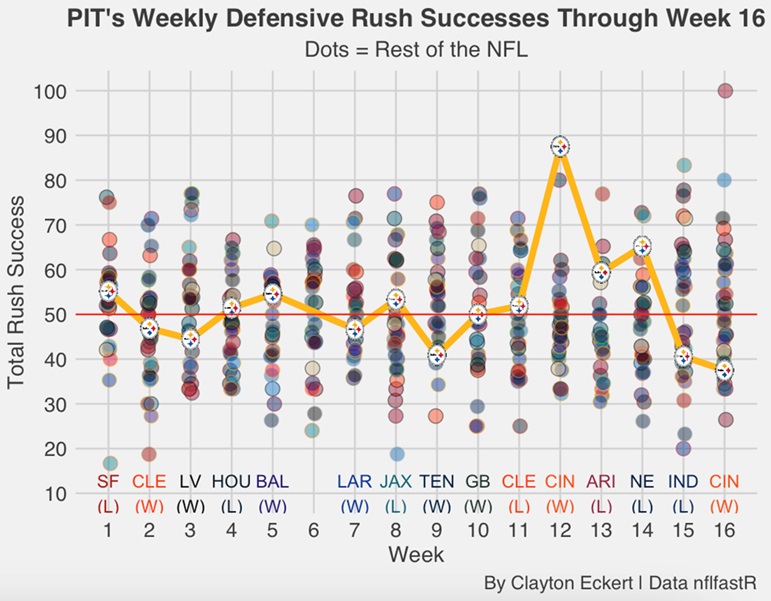Today, I wanted to look at how run defenses have fared through Week 16, using success rates by down, game halves, and weekly views as well. Let’s jump right in.
First, let’s look at early down success rates league-wide (with scrambles, kneels, and aborted/penalty plays excluded):
- First Down Passing Success = A rush that gains less than 40% of the needed yardage.
- Second Down Passing Success = A rush that gains less than 50% of the needed yardage.
The Pittsburgh Steelers defense has been one of the strongest teams in the league at limiting first down runs, with a 59.1 success rate that ranks third in the NFL. Very impressive to limit the opposition to three yards or less at that rate, among some of the best total run defenses in football, topped by only Cleveland (61.2) and New England (60.2) on first down.
Then there’s second down, where Pittsburgh drops to a below-average 43.2 rush success rate allowed, ranking 20th. I have highlighted throughout the season that second down has been an issue on both sides of the ball, and leads to more drive-extending plays or advantageous money downs.
Speaking of which, let’s look at late downs, where third and fourth downs that do not pick up a first down are considered a success:
We see a matching rank of 20th for Pittsburgh’s defense on money downs, hammering the previous point on their second down issue, limiting their ability to be consistently successful, with a 40.4 late down rush success rate.
Here are the total success rates, now that we’ve gained context by down:
The 2023 Steelers defense has a solid 51.1 total rush success rate through Week 16, ranking 10th in the NFL. They have been impressively stout on first down, a top three unit in the league, obviously the most common down, and providing quality and quantity here, which deserves major props. Outside of first downs, though, Pittsburgh ranks 20th, which should be a focus and will hopefully improve in the final two-game push to close the year.
I was also curious to see how defenses have performed by half:
Here we see the Steelers’ run defense has been better in the first half, with a 51.1 success rate that ranks ninth league-wide. In the second half (including overtime), Pittsburgh’s rate stands pat (51.1), but moves down in the ranks a bit to 13th. So, they have done a nice job of not allowing the opposition traction as games wear on, compared to doing so in terms of down and distance.
Speaking of that, here’s a table to investigate the half results further, including ranks by down:
This view highlights room for improvement in the second half, where first and second downs drop six ranks each. Encouragingly, the Pittsburgh Steelers’ defense has been slightly better on late downs in the second half, moving up one spot in the ranks. Of course, it would be great to see that improve even more to close out 2023, with their ability or lack thereof, second downs in the second half being vital in that hopeful goal.
To wrap up, let’s look at a weekly breakdown for added context:
Following much more stable results through Week 11 overall, the visual highlights Pittsburgh’s defense being very volatile the last five games, and their lowest success rate results in the last two games. Some of this could be attributed to injuries, but every team is expected to overcome and will be needed to improve hopeful playoff chances.
The best performance of 2023 came in the first matchup against Cincinnati in Week 12.
In the 16-10 win, the Steelers stepped up with the second-best 87.5 run success rate in all of 2023 league-wide, limiting RB Joe Mixon to only 16 yards, impressively. They got away from their running game confusingly, considering it being the first game with backup QB Jake Browning and the tight scoreboard, with the fewest eight rush attempts the Steelers have faced all season by far.
The Bengals definitely adjusted in the Week 16 rematch, doubling their rushing attempts (16) despite the Steelers’ offense getting up on the scoreboard early and refreshingly, in the 34-11 victory and season sweep of Cincinnati. The win was largely encouraging, but Pittsburgh’s run defense had its lowest rush success rate of 2023 (37.5), allowing 59 yards to RBs and 4.0 yards per carry.
Previously against Indianapolis in Week 15 was Pittsburgh’s second lowest rush success rate allowed (40.6). This was the most concerning performance of the last two games, with 32 attempts largely from backup running backs, and allowing 170 yards (5.3 yards per carry). They imposed their will, including the well-documented 13 straight runs that were demoralizing on Pittsburgh’s run defense, coasting to the Colts’ 30-13 victory.
Pittsburgh’s second and third-best rush success rates preceded this but unfortunately resulted in historically painful losses to, at the time, 2-10 teams. The Week 14 game against the Patriots included a 65.2 rush success rate on defense, allowing 81 yards and 3.5 yards per carry in the 21-18 loss.
Then, Pittsburgh’s third-best 59.4 success rate this season was against Arizona in Week 13. This was a bit surprising to see considering their 144 total rushing yards, including former Steelers RB James Conner’s 100-yard/two-touchdown day and fellow RB Michael Carter adding 25 yards on just four attempts.
This game emphasizes the importance of context, with Conner having three ten-plus yard runs (long of 29), and Carter getting most of his yardage on a 19 yarder. So, what happens on unsuccessful reps can completely scrap what appears to be an encouraging defensive success rate against the run.
So, we can see there is volatility to Pittsburgh’s three best weekly success rates in run defense, with a 1-2 record, and are coming off their two lowest results of 2023 to boot. On the season, their best attribute by far has been first downs, ranking impressively at third in the NFL. From there, they drop to 20th on second and late downs, which pulls their total success rate to 10th league-wide. Pittsburgh also wanes a bit in the second half on early downs but, encouragingly, has stayed firm on money downs throughout games.
Here’s to hoping Pittsburgh’s run defense can provide stout performances in the final two games against Seattle, who average four yards per carry (21st), and a hopefully meaningful game against the divisional rival Ravens, who comfortably lead the league with 2,395 rushing yards.
Thanks for reading, and let me know your thoughts in the comments.

